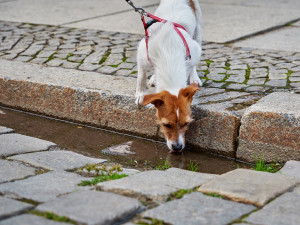Distemper in Dogs: Symptoms, Treatment, and Prevention
Learn the signs and symptoms of this dangerous pathogen.
In This Article:
What Is Canine Distemper? How Canine Distemper Spreads Canine Distemper Signs and Symptoms How Is Canine Distemper Diagnosed? Canine Distemper Treatment and Recovery How to Prevent Canine Distemper Frequently Asked Questions
If you’ve ever looked at your dog’s vaccination records, you’ve likely seen the letters DHLPP or something similar. Try as you might, you can’t spell at word with those letters, so what’s your vet trying to pull? Rather than a vaccination for one disease, this is actually an acronym for multiple illnesses your dog is protected against with this combination vaccine, standing for distemper, hepatitis, leptospirosis, parvo and parainfluenza.
Here, we take a look at distemper so you can get a better understanding why your vet is pushing this all-important vaccine.
How much do you spend on your pet per year?
What is canine distemper?
Canine distemper is a highly contagious and potentially fatal disease that affects dogs, puppies, and many species of wildlife. Caused by the canine distemper virus (CDV), distemper targets the immune system which can affect multiple body systems — respiratory, gastrointestinal, and nervous — and has up to an 80 percent mortality rate.
Even after recovery, this disease can still have lasting effects, making the canine distemper virus one of the most dangerous pathogens your dog can encounter.
Which dogs are most at risk for canine distemper?
While all dogs can be a target for distemper, staying up to date on vaccinations have drastically decreased the likelihood that vaccinated adults get the disease. That leaves unvaccinated adults and puppies, especially those younger than four months old, most at risk.
Puppies are particularly susceptible to distemper because their immune system is still trying to figure things out and it’s not yet running at full capacity. Even if they’ve had a puppy shot or two, they’re not fully protected until they have completed the series.
How canine distemper spreads
Canine distemper virus loves to take to the air, making it highly contagious when a dog comes in close contact with an infected animal. Coughing, sneezing, or even barking can transmit the infection from one dog to the next, especially when multiple animals are close together.
This makes dogs who are boarded, groomed, or that frequent the dog park most at risk. Distemper is spread very similarly to how kennel cough is transmitted. Because some wildlife can also have distemper, even homebody dogs who rarely see another pup can become infected.
The virus can also be spread on shared objects, such as food and water bowls, where the infected secretions are passed on to the next critter.
Canine distemper signs and symptoms
Distemper infections in dogs typically start out very mild, and the cold-like signs are often mistaken for other illnesses. As the disease progresses, the signs may start to shift from mild to more severe if it starts involving the nervous system. Common signs and symptoms of distemper include:
Coughing
Sneezing
Discharge from eyes and nose
Fever
Since distemper also affects the nervous system, the signs and symptoms listed above may be accompanied by:
Circling
Muscle twitching
Head tilt
Nystagmus (rapid, uncontrolled eye movement)
Jaw chewing and drooling
Partial or full paralysis
Some dogs will also develop thickened and hardened foot pads and nose skin. In young puppies, it may also cause damage to their adult teeth.
Dogs can be infected with distemper for up to three weeks before they begin to exhibit sickness, so it’s vital that they are seen by a veterinarian immediately after any signs and symptoms manifest.
How is canine distemper diagnosed?
With the majority of distemper signs being so similar to other illnesses in dogs, the diagnosis can be a bit confusing at first. Veterinarians may perform blood work or imaging to rule out other illnesses, or they may head directly for a distemper PCR test that looks for the distemper virus’s genetic material in a dog’s blood.
Another way of checking for exposure to the distemper virus is a blood antibody test. When a dog is vaccinated or exposed to the distemper virus, their body should start to produce antibodies to it so that the next time they see it, they will be ready. However, this test can’t differentiate between a dog naturally exposed to the virus and one that’s vaccinated against it, so it’s more commonly used to assess a dog’s immunity rather than to diagnose.
Canine distemper treatment and recovery
There is currently no cure for distemper. Treatment for canine distemper consists of hospitalization and supportive care. Multiple factors can affect the success of treatment and speed of recovery, including age, vaccination status, general health, and how quickly the dog’s immune system responds to the infection.
Treatments include:
Intravenous fluids and nutrients to combat dehydration and malnutrition
Antibiotics to prevent secondary bacterial infections
Medications to relieve vomiting/diarrhea
Sedatives to control seizures
Analgesics to alleviate pain
Steroids, if cerebral edema (swelling around the brain) is suspected
Even if a dog recovers from an acute canine distemper infection, the effects of the virus can cause varying levels of permanent neurological damage, as well as compromised tooth enamel and hardening of the nose and foot pads. In some cases, distemper’s neurological symptoms can be controlled by medications, but this depends on the severity of the symptoms and quality of life of the dog.
After clinical recovery, dogs may continue to shed the distemper virus for several months, so they should be kept away from unvaccinated puppies or other areas where dogs congregate. With follow-up testing, your veterinarian can determine when it’s safe to reintroduce recovered dogs into the general population.
How to prevent canine distemper
Vaccination and safe habits are the best defense against canine distemper. The distemper vaccine (DHLPP) should be given to puppies starting at six to eight weeks of age, repeated every three to four weeks until the puppy is 16 weeks old, and then given once a year. Keep puppies away from areas where dogs congregate and separate them from other unvaccinated or potentially infected dogs until their vaccination course is complete.
Keeping dogs away from wildlife is also important, as distemper can be carried by raccoons, foxes, coyotes, skunks and other woodland animals.
The canine distemper virus is not particularly hardy outside the body and can’t persist in the environment for long periods, so cleaning protocols are relatively easy to maintain. Dilute bleach and most household disinfectants will kill the virus on hard surfaces. In addition to cleaning, always sanitize exposed bedding, toys, and food and water bowls.
Instances of canine distemper infections in domestic animals have been drastically lowered with the introduction of vaccines. But it still remains a regular cause of mortality among stray or unvaccinated populations.
Bottom line
Canine distemper is a potentially fatal and serious disease in dogs that affects puppies and unvaccinated dogs the hardest.
There is no cure for distemper, so supportive treatment is the best a veterinarian can do. Even with supportive care, dogs may suffer permanent nerve, tooth, or foot-pad damage.
Fortunately, the incidence of distemper in dogs has drastically been cut down due to proper vaccination.
FAQs
Can dogs survive distemper on their own?
Distemper is a serious disease that is very unlikely to go away on its own. Even with prompt treatment, some dogs may die and others may suffer permanent damages. Not only does treatment help save a dog’s life, it can also cut down on the transmission of the virus to other animals.
Can I touch a dog with distemper?
Distemper isn’t contagious to humans. It’s not something you can get sick from, so it’s perfectly okay to touch a dog with distemper. However, you can transmit the virus to other dogs if you touch a pup that’s sick and then touch another dog or their things before washing your hands. Proper hygiene, not only for the things your sick dog comes in contact with but also what you come in contact with, is extremely important when dealing with a distemper infection.
How long does it take dogs to recover from distemper?
The recovery time for distemper is going to vary with each case. Most healthy dogs with proper treatment may recover within a few days, while others won’t recover at all. Some may take weeks or even months and some may have lifelong nervous issues. It all depends on the severity of the infection, a dog’s response, and whether they had proper treatment.












